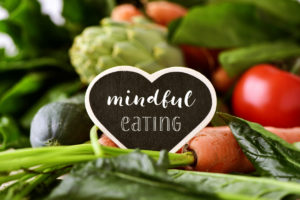
Mindful Eating
Mindful eating is not something most people in our busy world do on a regular basis. In a world where snack foods are sold in “cup-sized” containers to fit in our car’s cup holders, we tend to focus on the speedy delivery of food, not in savoring it.
If you’d like to get away from this crazy treadmill of meals, mindful eating is worth investigating. Best of all, you don’t need any fancy book to tell you how to do it or any special gear, either–just you, your brain, your mouth and food.
The practice of mindfulness has “its roots in Buddhist meditation,” per The University of Berkeley’s Greater Good Science Center. The “…secular practice of mindfulness has entered the American mainstream in recent years, in part through the work of Jon Kabat-Zinn and his Mindfulness-Based Stress Reduction (MBSR) program, which he launched at the University of Massachusetts Medical School in 1979.”
Method of Mindful Eating
This method of paying specific attention to the activity at hand encourages you to focus on the sensations around you at any given time. During times of high stress or anxiety paying attention to the sensations you are feeling and to your breathing will help you to keep you calm in the moment and think clearly about your responses and reactions.
The same ideas apply to eating. Pay attention to when and where you eat. Plan to eat your food without any distractions, like driving, working on the computer or watching TV. Make sure you listen to your body for physical hunger cues—an empty, rumbling stomach is a great start. It’s surprising how often we reach for food because it’s a certain time or because we are bored, or stressed or anxious. When you eat, be sure to take a moment to look at the food on the plate. If you are so inclined, take a moment to lay out your food in a desirable way. Part of eating happens with our eyes! Add some colored vegetables for a bright spot on your plate.
Take a whiff. How does it smell? Do you like how it looks? Just how many seeds are sprinkled across the top of your whole-wheat crust, anyway? What does your food sound like as you bite into it? Nothing beats the crunch of a crisp apple, or the feel of warm, toasted bread in your hand.
Notice signs of hunger abating. And remember that it takes about 20 minutes for your brain to register that you are full. Take a break from eating to let your body digest. Then decide if you are ready for more food or not.
After You’ve Eaten
The other part of mindful eating comes after you’ve eaten. Ask yourself how you felt as you were eating the food. Certain foods taste wonderful going down…like a whole sleeve of Oreo cookies. But the subsequent sugar high (and crash) leave you feeling sick and guilty. Store that information for future use, and start to make conscious choices when deciding what to eat. What does your body need for its well-being?
If you are a praying person, a prayer before or after a meal, appreciating the gift of food is also a good way to put the focus on the reason we are eating and to get yourself out of the habit of eating due to stress.
Studies show that mindfulness throughout the day, not just while eating, helps people to make better choices about when to eat and what to eat. Want to learn more about mindfulness? Take this Greater Good Science Center quiz to learn how mindful you are, and what you can do to cultivate mindfulness.





